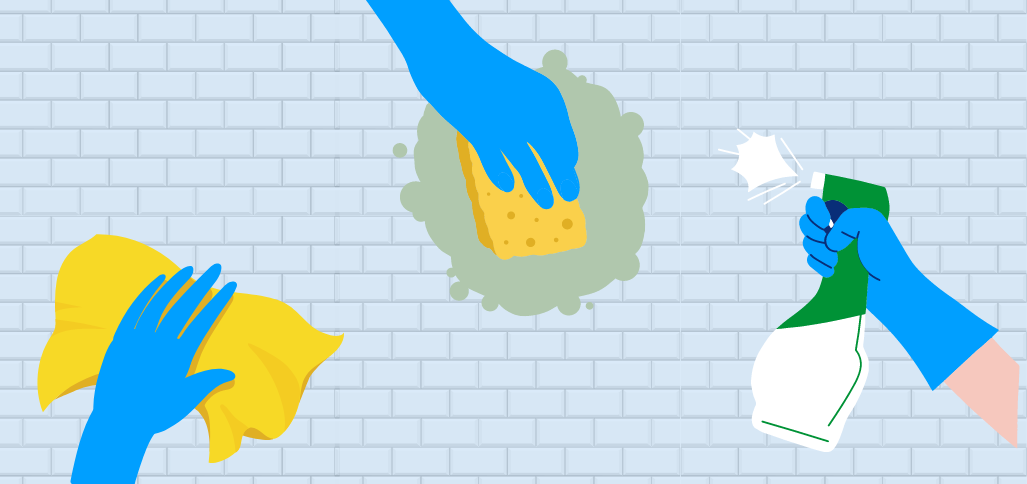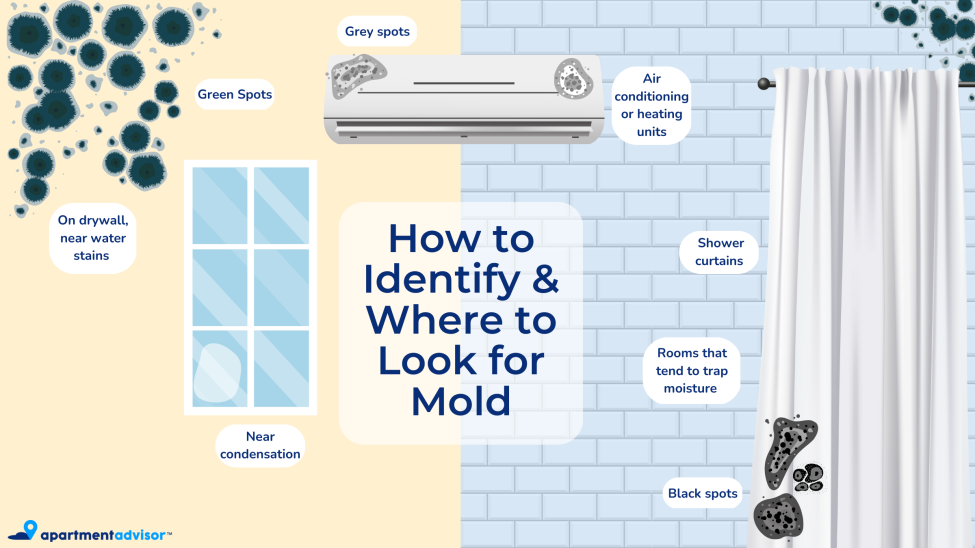
Think Your Apartment Has Mold? Here’s What to Do

By Lilly Milman
Mar 21, 2023
We all fear it: Seeing the black, green, gray, or white mold spots start creeping around the corners of our bathroom walls, air conditioning units, and other damp areas in our homes. Not only is it a pain to get rid of, but it can also be a health hazard. Unfortunately, mold is very common in homes and apartments and there’s not much you can do to avoid it forever — especially if your bathroom doesn’t have good ventilation or you live in a more humid climate. However, if you suspect your apartment does have a mold problem, the good news is that you can often nip it in the bud. If it does become a more serious issue, you also may have rights as the tenant that protect you from having to fix it yourself — especially if it has caused health problems.
Mold growth is a serious issue and should not be taken lightly, so if you think you have mold in your apartment, it’s time to act. Using official instructions from the Environmental Protections Agency (EPA) and the Center for Disease Control (CDC), we created a guide for what to do if you suspect there’s mold in your apartment.
We cover:
- What Causes Mold
- How to Spot Mold
- What to Do if You Find Mold
- How to Prevent Mold
- Tenants’ Rights with Mold
Keep reading for our full guide on how to identify mold in your apartment, how to determine the severity of the issue, how to clean mold and avoid it coming back in the future, and more.
Mold grows where there is high humidity or a high moisture level. Mold spores, which are always present in the air outside, can be brought inside through an open window or door or on your clothes. The spores will begin to grow mold inside if they land on wet surfaces. Floods, water damage, and leaks are a common cause of mold, as well as lack of ventilation in rooms that collect moisture like the bathroom. If you often shower while keeping all bathroom windows and doors closed, this could create an environment that makes it easy for mold to grow.
If there’s mold present in your apartment, you most likely will be able to see or smell it. Mold can come in many colors, but the mold you’ll most commonly find in a home will be black, grey, or green spots. It may be slimy or fuzzy in appearance. Color is not an indication of how dangerous a particular mold is, according to the CDC. Mold will also bring an earthy and musty odor to the room.

If you smell mold in your bathroom, check:
- Your shower curtain
- The corners and ceiling of the room
- Under any rugs or bathmats
It’s possible that the problem isn’t in your bathroom. Also check:
- In your basement or attic, if you have one
- Around laundry machines
- Any air conditioning or heating units
- Around windows, especially if you see condensation appearing on the glass
- Anywhere in your home where you suspect there is or has been a leak
- Any paper products, cardboard, wood products, dust, carpet, fabric, or upholstery that may have gotten wet at any point
If you can’t see mold anywhere, it may be hidden. If this is the case, it will make taking care of the problem a bit trickier and you may need your landlord or property manager’s help to find it, so alert them of the smell as soon as possible. They may need to employ a professional. Hidden mold may be:
- Behind dry wall, wallpaper, paneling, or ceiling tiles
- Under carpets and rugs
- On the surface of walls behind furniture
- Inside ductwork
- Inside your walls around pipework
Look for water stains, which can lead you to the source of the mold.
Another sign of mold is if you are having physical reactions at home. Prolonged mold exposure can irritate the eyes, skin, nose, throat, and lung, causing hay fever–like symptoms like a stuffy nose, wheezing, red and itchy eyes, and rashes on the skin. If you have asthma and/or are allergic to mold, it can cause asthma attacks. According to the CDC, there is currently no clinically proven test that can tell whether a person has been exposed to mold. If you are having health issues related to mold, see a healthcare professional immediately.
First things first, don’t panic — and don’t pull out a test kit. Both the CDC and the EPA recommend that you do not do any mold testing. In their guide on mold, the CDC writes: “You do not need to know the type of mold growing in your home… No matter what type of mold is present, you should remove it.”
If the patch of mold is small enough — taking up less than a 3-foot by 3-foot area — you can safely remove it yourself, according to the EPA. The faster you get rid of mold, the less damage it can do to your belongings and the less opportunity it has to spread. If you’ve determined you’d like to do the job yourself, then put on some rubber gloves, a well-fitting N-95 mask, and a pair of goggles, and follow the below steps to start your clean up.
- Remove the moldy items. You will need to dispose of any items that are porous and covered in mold and remove them from your living area. Carpets, drywall, and ceiling tiles that have been affected by mold will need to be removed and replaced.
- Scrub cleanable surfaces. Using either soapy water or a solution of bleach and water (remember: do not ever mix bleach with other household cleaners), start scrubbing any hard surfaces that have been affected by the mold, including: wood, tile, stone, metal furniture, countertops, sinks, showers and/or tubs.
- Dry the clean areas completely. Since moisture is the source of mold, you want to make sure to dry any area that you are cleaning as soon as you are done. If you have a fan, air conditioner, or dehumidifier that wasn’t affected by the mold that you can turn on, do so when you’re done cleaning.
- Fix the moisture problem. You will never be able to get rid of the mold in your apartment if you don’t address what caused the infestation in the first place. If it’s in your control, make sure to start monitoring the moisture in the area where the mold grew. For example, if it was in the bathroom, start opening the bathroom window or running the fan when you shower. If you live in a very humid climate, invest in a dehumidifier to keep the inside of your apartment at less than 60% humidity.
If the mold-affected area is too large for you to clean yourself, then contact your landlord or property manager for help. Take and send photos of the mold to them.
If you have renters insurance and a personal item you owned was ruined by mold, you may be able to submit a claim to your insurance company.
The best way to prevent mold is by not creating an environment where it is able to grow, which means controlling moisture. Cleaning up spills or water leaks as soon as they happen; using air conditioners and dehumidifiers to keep your humidity levels down; and increasing ventilation in your kitchen, bathroom, and laundry room are all ways you can prevent mold.
If you suspect the issue is not in your control — like a plumbing leak — then contact your landlord or property manager immediately. Yours may not be the only rental unit affected, and they may need to take a more aggressive approach to rid the property of mold.
If you find yourself in a moldy apartment, you may be wondering what your rights are as a tenant. The answer to this important question, unfortunately, is not always straightforward, as your rights vary from state to state. There is no federal law that requires landlords to disclose a mold infestation in a rental property to tenants, but most states have laws requiring this. Always start by checking your lease agreement to see if there are any clauses directly related to mold remediation.
Warranty of habitability laws, which outline the rights of tenants to a safe and habitable living environment, also vary from state to state. In most states, your landlord will be responsible for the removal of mold if it has grown because of something related to an issue with the property (like a leaky roof or pipe). It is usually your landlord’s responsibility to address your mold issue in a timely matter, especially if you are experiencing health effects — but if the mold was caused by your actions (like if you created a humid environment in your bathroom by showering with the windows closed), you may be responsible for paying for the mold removal.
If your landlord has been notified of the mold and is not addressing its removal, then you may consider contacting local, state, or federal health or housing authorities or your state’s health department. In this case, you may also have a valid legal claim against your landlord.
The Bottom Line
Mold in your apartment is never fun, but it also isn't always the end of the world. Find the source ASAP and let your landlord know if the cause of the mold is out of your control. Focus on clean up rather than on testing the mold — and don't get caught up in myths about mold, like the idea that black mold is more toxic and dangerous than other kinds of mold. There is currently no research that proves color is an indicator of a mold's danger to humans.
Top cities
Atlanta Apartments
1,999 apartments starting at $600/month
Austin Apartments
4,949 apartments starting at $600/month
Baltimore Apartments
1,472 apartments starting at $500/month
Boston Apartments
3,499 apartments starting at $940/month
Charlotte Apartments
2,903 apartments starting at $450/month
Chicago Apartments
4,012 apartments starting at $450/month
Dallas Apartments
5,609 apartments starting at $604/month
Fort Worth Apartments
2,193 apartments starting at $600/month
Houston Apartments
4,504 apartments starting at $590/month
Las Vegas Apartments
1,081 apartments starting at $704/month
Los Angeles Apartments
11,535 apartments starting at $625/month
Miami Apartments
544 apartments starting at $1,000/month
Milwaukee Apartments
928 apartments starting at $465/month
New York Apartments
4,118 apartments starting at $488/month
Oakland Apartments
608 apartments starting at $885/month
Orlando Apartments
842 apartments starting at $825/month
Philadelphia Apartments
3,657 apartments starting at $550/month
Phoenix Apartments
4,153 apartments starting at $599/month
Pittsburgh Apartments
1,223 apartments starting at $600/month
Portland Apartments
2,519 apartments starting at $599/month
Raleigh Apartments
1,367 apartments starting at $750/month
San Antonio Apartments
3,925 apartments starting at $525/month
San Diego Apartments
2,960 apartments starting at $650/month
San Francisco Apartments
436 apartments starting at $675/month
San Jose Apartments
405 apartments starting at $1,300/month
Seattle Apartments
3,623 apartments starting at $450/month
Tampa Apartments
1,078 apartments starting at $800/month
Washington DC Apartments
2,878 apartments starting at $745/month